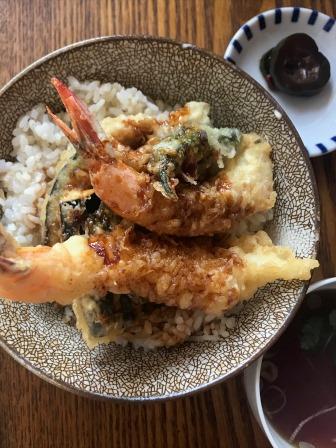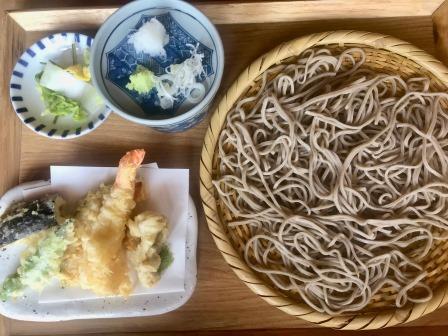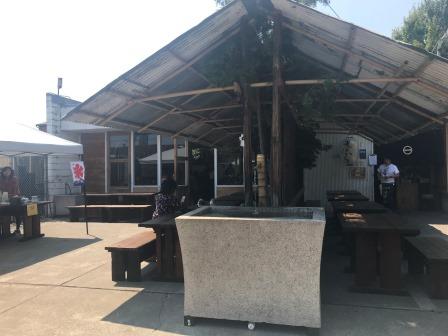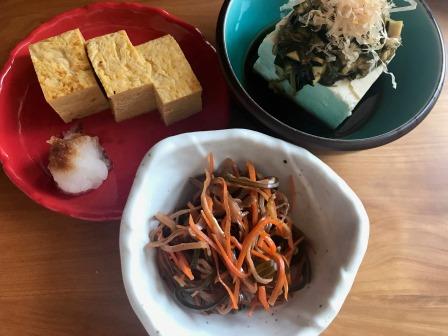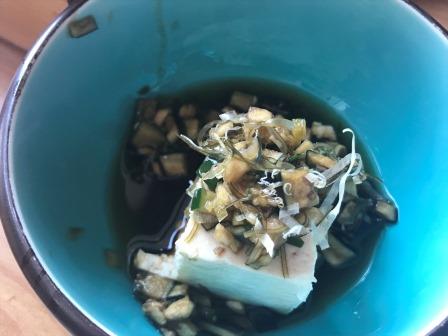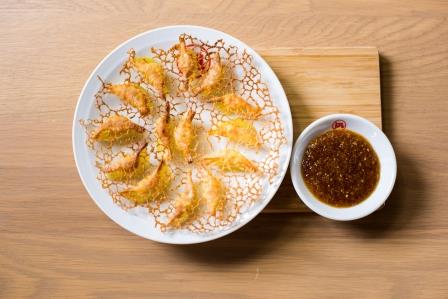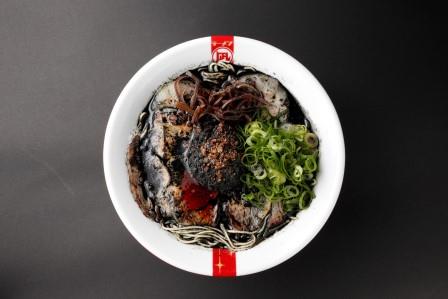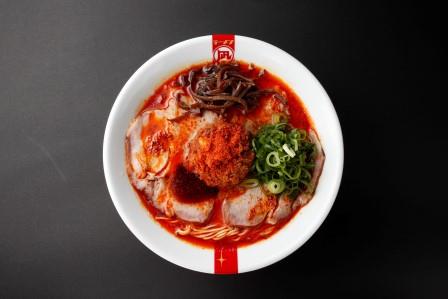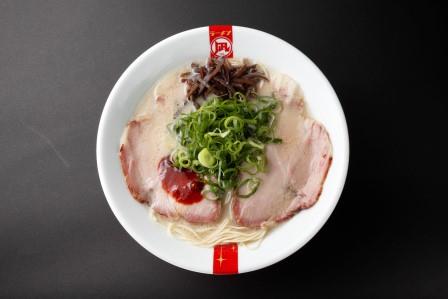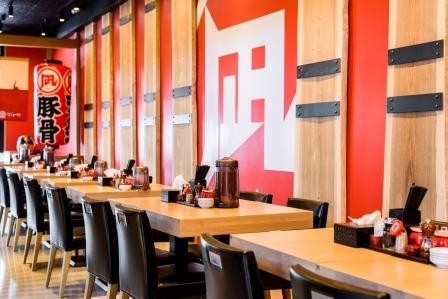A new notable sight is born in Little Tokyo
By Keiko Fukuda
A takoyaki food truck first appeared in the Los Angeles area a few years ago. Back then, Okonomiyaki restaurants had already existed, but there were no takoyaki restaurants. Every time I came across the takoyaki food truck, I would run to it so I wouldn’t miss the opportunity to taste takoyaki. The name of the takoyaki establishment is TaNoTa. It consists of the three first syllables of the names of the Japanese men who contributed to the founding of this business.
In March of 2018, TaNoTa opened a restaurant at the entrance of the Japanese Village Plaza, the center location of Little Tokyo, where many local Asians, Americans who love Japanese cultures, and tourists hang out. There is a take-out order counter and 6 seating spaces only; however, you can also order and taste takoyaki at the tables of the okonomiyaki restaurant, Chinchikurin, because theyshare the restaurant space with them.
The owner, Takeo Shibatani, who represents the first syllable, Ta of TaNoTa, came to Los Angeles with the hopes of starting both a surfing and a Japanese food business after retiring from the eat-out restaurant industry in Japan. Shibatani, who is from Osaka, noticed the fact that there was no place in Los Angeles, where authentic takoyaki was served yet, and decided to launch the takoyaki business as his Japanese food business goal. However, he did not have enough money to open a restaurant, so he got money invested by a friend whose name represents the second syllable, No, and started to sell takoyaki on a food truck as the start, in 2010.
Along with the sales from using the food truck, he aggressively pushed the sales at various events, which he still does presently. “I tried to sell takoyaki at an event before starting the food truck business. It was a huge hit. People waited in line for an hour to buy. Most of them were not even Japanese!” He sold out 500 meals.
Even now, they still participate in various events 70 times a year. They are especially the busiest in the summer when many outdoor festivals are held. They are also busy with China-related festivals during the Chinese New Year celebration.
The menu of the long-awaited restaurant, which opened on the street corner, consists of 7 kinds of takoyaki; original, jalapeño, ponzu, wasabi, mentaiko, sesame, and parmigiana truffle, and some side menu items; 3 kinds of shaved ice, beers and Japanese sake. “I often see people working in the area leisurely drop by to have a drink, ordering takoyaki as nibbles,” says Shibatani. He expressed an idea for the future to offer a beer and takoyaki set menu for the happy-hour customers.
Most importantly, the takoyaki is cooked carefully with machines which are manufactured by the partner company, Chinchikurin. The 7 different flavors are differentiated by the sauces. I tried the parmigiana truffle kind. The hot melted cheese went superbly well with the takoyaki!
In fact, Shibatani’s company also takes on a wholesale business of frozen takoyaki for other restaurants besides the sales at his own restaurant, and at the various events.
“I was convinced that I would succeed with takoyaki when I was working at a friend’s ramen restaurant before I started my own business. They had takoyaki as a side menu item, and it was selling very well,” says Shibutani. Moreover, the company sells takoyaki makers manufactured by Chinchikurin. I must say that they seem to be controlling the takoyaki business single-handedly.
It was 2 o’clock in the afternoon of a weekday when I visited. The Japanese Village Plaza, where this restaurant is located, was busy as usual with many people. 10 years or so ago, you could not imagine such popularity of the area. You hardly saw any one walking in the area. However, the town was revived by the opening of series of popular restaurants in Little Tokyo, which include Daikokuya (ramen), Monzo (udon), Kura (revolving sushi), and Shinsengumi (yakitori and ramen), which have been attracting so many people into the area. I would like to see TaNoTa (takoyaki) grow to become one of such magnetic places, which draw people into the area.
リトルトーキョーの新名所誕生
遡ること数年前にたこ焼きのフードトラックがロサンゼルス周辺に登場した。当時、お好み焼き屋はあったが、たこ焼き屋はなかった。そのフードトラックを見かけるとチャンスを逃してはならないとばかりに買い求めたものだ。
たこ焼き屋の名はTaNoTa。創業に携わった3人の日本人男性の名前の最初の一文字ずつを組み合わせたそうだ。
2018年3月、TaNoTaは、アジア系のローカルや日本文化好きのアメリカ人、また観光客で賑わうリトルトーキョーの中心地、ジャパニーズヴィレッジプラザの入り口に店を構えた。持ち帰りと6席のカウンターのスペースだが、実はお好み焼きのちんちくりんとコラボレーションした店内になっているため、ちんちくりんのテーブルでもTaNoTaのたこ焼きを味わうことができる。
TaNoTaの最初のTaを表すオーナーの柴谷健雄(ルビ:しばたにたけお)さんは、日本の外食産業を辞め、「サーフィンと日本食ビジネスの起業ができる土地」としてロサンゼルスに渡った。大阪出身の柴谷さんは、「ロサンゼルスに本格的なたこ焼きを出す店がない」ことに着目し、扱う日本食をたこ焼きに決めた。しかし、店を出す資金がない。そこでTaNoTaのNoを表す友人の出資を受け、まずはフードトラックでの販売を開始。2010年のことだった。
並行して今も続けているイベントでのブース販売にも力を入れた。「フードトラックより前にイベントに初めて出展したら大当たり。1時間待ちの行列ができて、ほとんど日本人以外のお客さんが並んでくれたんです」。500食を完売した。
現在も年間70日はイベントに出展しているという。屋外のフェスティバルが多い夏は特に書き入れ時。さらにチャイニーズニューイヤーの時期も中国系のお祭りが多い。
そして、満を持して開けた路面店のメニューには、オリジナル、ハラペニョ、ポン酢、わさび、明太子、ごま、パルメジャントリュフの7種類のたこ焼きとサイドメニュー、3種類のかき氷、ビールと日本酒が並ぶ。「この辺りにお勤めの方が夕方ふらっと寄って、たこ焼きをつまみに1杯だけ飲んでいくというスタイルもよく見られます」と柴谷さん。今後はハッピーアワーの顧客向けにビールとたこ焼きのセットメニューなども提供していきたいと語る。
肝心のたこ焼きは、コラボパートナーのちんちくりんの会社が製造している機械で丁寧に焼かれる。7つの種類はソースで差別化を図る。この日試食したパルメジャントリュフは、熱でとろりと溶けたチーズとたこ焼きの相性が抜群。
実は柴谷さんの会社では、自分の店舗やイベントでたこ焼きを販売するだけでなく、レストランに向けての冷凍たこ焼きのホールセールも手がけている。「店を出す前に知り合いのラーメン店を手伝っていた時に、サイドメニューとしてたこ焼きが良く売れているのを目の当たりにして、手応えを感じたんです」。さらにはちんちくりん製のたこ焼き製造機も販売もしているとあって、たこ焼きビジネスを一手に担っていると言えそうだ。
取材に訪れた日は平日の午後2時。この日も店が位置するジャパニーズヴィレッジプラザは多くの人が行き交っていた。10年以上前は、このような賑わいは想像もできないほど閑散としていた。しかし、ラーメンの大黒家、うどんのもんぞう、回転寿司のクラ、焼き鳥とラーメンの新撰組と繁盛店のリトルトーキョー進出で人々をこのエリアに次々に呼び込み、街は蘇った。TaNoTaのたこ焼きもまた、人々をこの地に引き付ける磁石のような存在に成長することを期待したい。
TaNoTa TAKOYAKI
350 E.1st St. Los Angeles CA 90012
(714)655-9821
https://www.takoyakitanota.com/
Mon+Wed.-Fri..11:30am-2:45pm, 5:00pm-10:30pm
Sat.+-Sun.11:30am-10:30pm
Tuesday Closed
A takoyaki food truck first appeared in the Los Angeles area a few years ago. Back then, Okonomiyaki restaurants had already existed, but there were no takoyaki restaurants. Every time I came across the takoyaki food truck, I would run to it so I wouldn’t miss the opportunity to taste takoyaki. The name of the takoyaki establishment is TaNoTa. It consists of the three first syllables of the names of the Japanese men who contributed to the founding of this business.
In March of 2018, TaNoTa opened a restaurant at the entrance of the Japanese Village Plaza, the center location of Little Tokyo, where many local Asians, Americans who love Japanese cultures, and tourists hang out. There is a take-out order counter and 6 seating spaces only; however, you can also order and taste takoyaki at the tables of the okonomiyaki restaurant, Chinchikurin, because theyshare the restaurant space with them.
The owner, Takeo Shibatani, who represents the first syllable, Ta of TaNoTa, came to Los Angeles with the hopes of starting both a surfing and a Japanese food business after retiring from the eat-out restaurant industry in Japan. Shibatani, who is from Osaka, noticed the fact that there was no place in Los Angeles, where authentic takoyaki was served yet, and decided to launch the takoyaki business as his Japanese food business goal. However, he did not have enough money to open a restaurant, so he got money invested by a friend whose name represents the second syllable, No, and started to sell takoyaki on a food truck as the start, in 2010.
Along with the sales from using the food truck, he aggressively pushed the sales at various events, which he still does presently. “I tried to sell takoyaki at an event before starting the food truck business. It was a huge hit. People waited in line for an hour to buy. Most of them were not even Japanese!” He sold out 500 meals.
Even now, they still participate in various events 70 times a year. They are especially the busiest in the summer when many outdoor festivals are held. They are also busy with China-related festivals during the Chinese New Year celebration.
The menu of the long-awaited restaurant, which opened on the street corner, consists of 7 kinds of takoyaki; original, jalapeño, ponzu, wasabi, mentaiko, sesame, and parmigiana truffle, and some side menu items; 3 kinds of shaved ice, beers and Japanese sake. “I often see people working in the area leisurely drop by to have a drink, ordering takoyaki as nibbles,” says Shibatani. He expressed an idea for the future to offer a beer and takoyaki set menu for the happy-hour customers.
Most importantly, the takoyaki is cooked carefully with machines which are manufactured by the partner company, Chinchikurin. The 7 different flavors are differentiated by the sauces. I tried the parmigiana truffle kind. The hot melted cheese went superbly well with the takoyaki!
In fact, Shibatani’s company also takes on a wholesale business of frozen takoyaki for other restaurants besides the sales at his own restaurant, and at the various events.
“I was convinced that I would succeed with takoyaki when I was working at a friend’s ramen restaurant before I started my own business. They had takoyaki as a side menu item, and it was selling very well,” says Shibutani. Moreover, the company sells takoyaki makers manufactured by Chinchikurin. I must say that they seem to be controlling the takoyaki business single-handedly.
It was 2 o’clock in the afternoon of a weekday when I visited. The Japanese Village Plaza, where this restaurant is located, was busy as usual with many people. 10 years or so ago, you could not imagine such popularity of the area. You hardly saw any one walking in the area. However, the town was revived by the opening of series of popular restaurants in Little Tokyo, which include Daikokuya (ramen), Monzo (udon), Kura (revolving sushi), and Shinsengumi (yakitori and ramen), which have been attracting so many people into the area. I would like to see TaNoTa (takoyaki) grow to become one of such magnetic places, which draw people into the area.
リトルトーキョーの新名所誕生
遡ること数年前にたこ焼きのフードトラックがロサンゼルス周辺に登場した。当時、お好み焼き屋はあったが、たこ焼き屋はなかった。そのフードトラックを見かけるとチャンスを逃してはならないとばかりに買い求めたものだ。
たこ焼き屋の名はTaNoTa。創業に携わった3人の日本人男性の名前の最初の一文字ずつを組み合わせたそうだ。
2018年3月、TaNoTaは、アジア系のローカルや日本文化好きのアメリカ人、また観光客で賑わうリトルトーキョーの中心地、ジャパニーズヴィレッジプラザの入り口に店を構えた。持ち帰りと6席のカウンターのスペースだが、実はお好み焼きのちんちくりんとコラボレーションした店内になっているため、ちんちくりんのテーブルでもTaNoTaのたこ焼きを味わうことができる。
TaNoTaの最初のTaを表すオーナーの柴谷健雄(ルビ:しばたにたけお)さんは、日本の外食産業を辞め、「サーフィンと日本食ビジネスの起業ができる土地」としてロサンゼルスに渡った。大阪出身の柴谷さんは、「ロサンゼルスに本格的なたこ焼きを出す店がない」ことに着目し、扱う日本食をたこ焼きに決めた。しかし、店を出す資金がない。そこでTaNoTaのNoを表す友人の出資を受け、まずはフードトラックでの販売を開始。2010年のことだった。
並行して今も続けているイベントでのブース販売にも力を入れた。「フードトラックより前にイベントに初めて出展したら大当たり。1時間待ちの行列ができて、ほとんど日本人以外のお客さんが並んでくれたんです」。500食を完売した。
現在も年間70日はイベントに出展しているという。屋外のフェスティバルが多い夏は特に書き入れ時。さらにチャイニーズニューイヤーの時期も中国系のお祭りが多い。
そして、満を持して開けた路面店のメニューには、オリジナル、ハラペニョ、ポン酢、わさび、明太子、ごま、パルメジャントリュフの7種類のたこ焼きとサイドメニュー、3種類のかき氷、ビールと日本酒が並ぶ。「この辺りにお勤めの方が夕方ふらっと寄って、たこ焼きをつまみに1杯だけ飲んでいくというスタイルもよく見られます」と柴谷さん。今後はハッピーアワーの顧客向けにビールとたこ焼きのセットメニューなども提供していきたいと語る。
肝心のたこ焼きは、コラボパートナーのちんちくりんの会社が製造している機械で丁寧に焼かれる。7つの種類はソースで差別化を図る。この日試食したパルメジャントリュフは、熱でとろりと溶けたチーズとたこ焼きの相性が抜群。
実は柴谷さんの会社では、自分の店舗やイベントでたこ焼きを販売するだけでなく、レストランに向けての冷凍たこ焼きのホールセールも手がけている。「店を出す前に知り合いのラーメン店を手伝っていた時に、サイドメニューとしてたこ焼きが良く売れているのを目の当たりにして、手応えを感じたんです」。さらにはちんちくりん製のたこ焼き製造機も販売もしているとあって、たこ焼きビジネスを一手に担っていると言えそうだ。
取材に訪れた日は平日の午後2時。この日も店が位置するジャパニーズヴィレッジプラザは多くの人が行き交っていた。10年以上前は、このような賑わいは想像もできないほど閑散としていた。しかし、ラーメンの大黒家、うどんのもんぞう、回転寿司のクラ、焼き鳥とラーメンの新撰組と繁盛店のリトルトーキョー進出で人々をこのエリアに次々に呼び込み、街は蘇った。TaNoTaのたこ焼きもまた、人々をこの地に引き付ける磁石のような存在に成長することを期待したい。
TaNoTa TAKOYAKI
350 E.1st St. Los Angeles CA 90012
(714)655-9821
https://www.takoyakitanota.com/
Mon+Wed.-Fri..11:30am-2:45pm, 5:00pm-10:30pm
Sat.+-Sun.11:30am-10:30pm
Tuesday Closed







